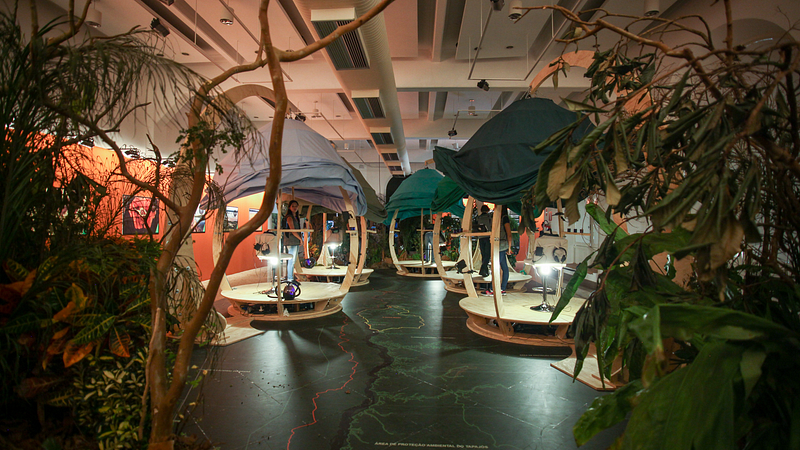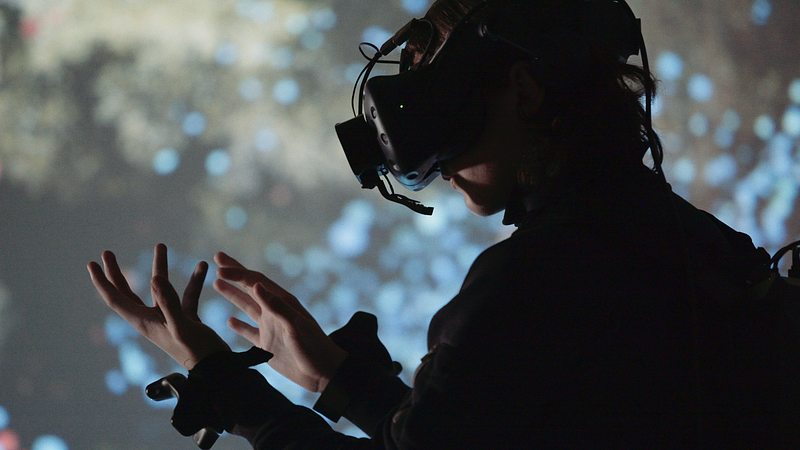Field Notes: “The Discord is Forever”
Festival highlights from Eyeo’s 10th (and final) convening

After two years on hiatus due to the pandemic, Eyeo celebrated its tenth festival with an in-person conference in Minneapolis, gathering creative technologists for presentations, workshops and meet-ups. A midwestern outpost among the handful of convenings for arts and technology communities in the US, Eyeo creates a large umbrella for a range of practices and interests. The festival’s mix of perspectives enables cross-disciplinary sparks, as well as in-depth conversations among specialists, ranging across virtual reality to microscopy, generative art, data visualization and more.
Themes of care, process and relationships ran across presentations and panels, responding to both pandemic stresses and two years of organizing and reflection following the murder of George Floyd in May 2020. A pre-un-conference on Code+Care invited attendees to propose self-organized sessions while the main conference included panels on thriving during the pandemic and fostering creative communities. Multiple panelists and presenters spoke to the time and trust involved in cultivating relationships with communities, contributors, and the natural world. On the personal and environmentally symbiotic side, this theme arose as “practicing slowness” and engaging in “acts of close attention.” In the workplace, speakers described reassessing values and creating space for needed conversations, underscoring a humane shift in working cultures over the past two years. On a more lighthearted side, presenters emphasized play and “making space for weirdness.”
Embodied Projects
For immersive storytellers, presentations featuring virtual reality and immersive installations provided a range of insights into cultivating atmosphere and engaging the full body.
L05 (Carlos Garcia) shared the process and installation of his 2019 immersive journey Atabey, additionally explored in a research study related to the project. Beginning with his family’s trajectory following the devastation in Puerto Rico by Hurricane Maria, L05 described learning about his grandparents through his parents, a process that deepened his relationships with dreams, memories and ancestors, while also spurring reflections on diasporic identity. In addition to conducting interviews and collecting family stories and memorabilia, L05 studied ancestral dream knowledge and kept a dream journal. Explorations of historic and artistic approaches to dreams led to research into cinematic methods of cultivating a dream atmosphere, such as focused points of visual or sonic detail, nonlinear approaches to space or time and exaggerated color palettes. Turning outward from the personal, L05 revealed how these aesthetic insights also informed his work on the virtual 2021 KID A MNESIA exhibition, marking two decades since the band Radiohead’s Kid A (2000) and Amnesiac (2001) albums.
 Installation view of Munduruku: The Fight to Defend the Heart of the Amazon
featuring multisensory immersive pods combining 360 VR film, binaural sound, scent, vibration,
humidity, touch, and temperature changes. Image courtesy of The Feelies.
Installation view of Munduruku: The Fight to Defend the Heart of the Amazon
featuring multisensory immersive pods combining 360 VR film, binaural sound, scent, vibration,
humidity, touch, and temperature changes. Image courtesy of The Feelies.Grace Boyle, founder and director of The Feelies, explored the expansive scope of awareness that informs immersive experience, alluding to up to 33 senses involved in perception. Describing the walking route to the Ise Jingu shrine in southeastern Japan, she led attendees through layers of sensations: the aroma of a cypress (hinoki) bridge, the microadjustments of balance and rhythmic sounds of gravel underfoot, the shift in air temperature and humidity as one enters a forest path and the sightlines revealed as the route winds its course. This multisensory journey laid the groundwork for drawing attention to the many senses that exist beyond the familiar five. Working in combination, the interplay of these senses creates a holistic impression that also unfolds over time. Sidestepping the dominance of the visual in media and storytelling, Boyle outlined ways that these many senses can be incorporated into crafting an immersive story arc.
Sharing the processes behind the multisensory 360 VR documentary Munduruku: The Fight to Defend the Heart of the Amazon, Boyle described the close collaboration with the Indigenous Munduruku community based in the Amazon’s Tapajós River basin in Brazil. In addition to advising on the project’s storyline, the community’s insights into the surrounding forest supported the design of sense stimuli, including scents developed by perfumer Nadjib Achaibou. Interviews, observations and scent lab analysis further contributed to the documentary’s multisensory components, which take audiences on an experiential arc within specially designed immersive modular pods.
 We Live
in an Ocean of Air. Image courtesy of Marshmallow Laser Feast.
We Live
in an Ocean of Air. Image courtesy of Marshmallow Laser Feast.Ersin Han Ersin, a member of the collective Marshmallow Laser Feast, shifted attendees’ point of reference, asking “What is it like to be a tree?” This prompt to consider the world from the vantage point of another organism served as an entry point to the multisensory immersive experience We Live in an Ocean of Air. Inspired by giant sequoia trees, some of the largest and longest living organisms on earth, the project revealed the trees’ symbiosis while also connecting to the bodies of visitors through sensors monitoring breath, heartbeat and movement. Created in collaboration with The Feelies, the installation’s multisensory narrative was anchored by an emotional arc woven together with a scentscape, soundscape and haptic storyline. Through such immersive storytelling, Ersin described the potential for new ways of comprehending fellow organisms and breaking habits of how we understand and observe other life forms. As a beginning, he directed audiences to the project Befriending A Tree by Chelsea Steinauer-Scudder.
Listening to Nature and One Another
Walter Kitundu offered another change of perspective, through both a closing night talk and a panel with Jenny Odell and Jer Thorp on the practice of bird watching. Emphasizing a relational ethic, panelists encouraged spending time, respecting birds as fellow beings who share this planet and teachers who help us learn how to pay attention. Kitundu’s project Ruupaywa — Songs of the Watershed combines this interest with a public art process honoring place and community, set for installation in the near future. In addition to a sculptural eagle sheltering a seating area and community archive, a soundscape will be installed throughout the gardens of the Alameda Creek Watershed Center. This soundscape, created in collaboration with the Indigenous Muwekma Ohlone community, entails translating phrases from the Chochenyo language into the melodic patterns of bird calls, creating a form of dialogue between humans and local flocks, as well as a language repository. Through this example, Kitundu also made the case for allocating adequate resources for community-based projects, which include time to build trust, space for the work to grow, flexibility to allow projects to change and funding to support all who participate.
Of particular relevance for documentarians, Dorothy R. Santos noted the common privileging of American and British accents and the English language across technology tools. She connected this thread to the way oral histories sound and her own experiences with accents growing up within Filipino communities in San Francisco. Sharing a web-based game The Cyborg’s Prosody she is creating that centers Tagalog and her mother’s vocal patterns, she encouraged users to not just listen, but to listen with care and intention. From this example, the presentation and conversation expanded to experimental methods of capturing oral histories, with Santos identifying both moments of silence and background noise as elements of holistic stories. The Q&A ended with forward-looking questions surrounding the compiling and storing of endless media files: How do you decide what to save? What do you let go of forever?
From Eyeo’s opening keynote by Suzanne Kite exploring Indigenous ontologies and relationships with the nonhuman to closing talks, the conference came full circle, traversing throughlines of care, community, embodiment and realignment with the natural world. This year’s festival brought back many well-known presenters from years past, particularly from coastal hubs, including a notable slate of presenters originally scheduled prior to pandemic shutdowns. While COVID exposures necessitated some last-minute speaker changes, the conference seemed to rekindle the spark of previous years, albeit in a masked version.
The festival was heightened by the added energy of convening afresh after pandemic isolation, as well as news that this will be the last Eyeo. How the organization may evolve remains in question, but this reconvening has launched momentum that will likely continue across a range of forms. In the meantime, the Eyeo archive offers a rich resource of past presentations, the community the festival has built is engaged and vibrant and, as one presenter noted, “the Discord is forever…”
Jessica Fiala is a research associate with 8 Bridges Workshop, an independent writer, and a company member of Ragamala Dance. Through practical experience, a culture of learning, and an individualized approach, 8 Bridges helps organizations across philanthropy, culture, and public media find their best way forward.
For more news, discourse, and resources on immersive and emerging forms of nonfiction media, sign up for our monthly newsletter.
Immerse is an initiative of the MIT Open DocLab and Dot Connector Studio, and receives funding from Just Films | Ford Foundation, the MacArthur Foundation, and the National Endowment for the Arts. The Gotham Film & Media Institute is our fiscal sponsor. Learn more here. We are committed to exploring and showcasing emerging nonfiction projects that push the boundaries of media and tackle issues of social justice — and rely on friends like you to sustain ourselves and grow. Join us by making a gift today.